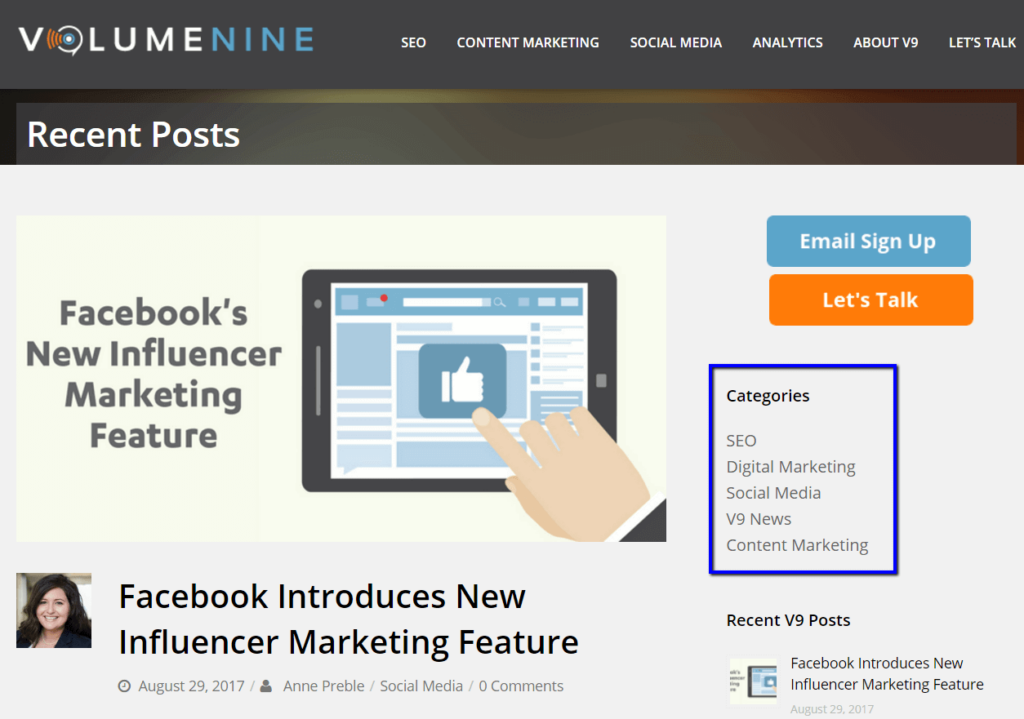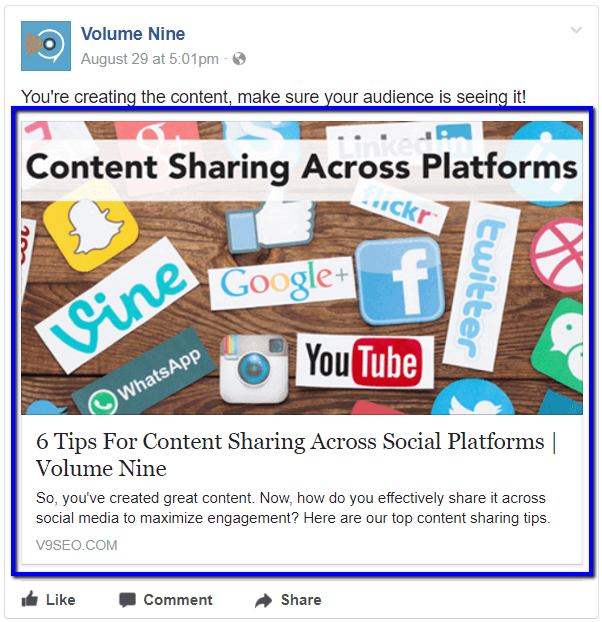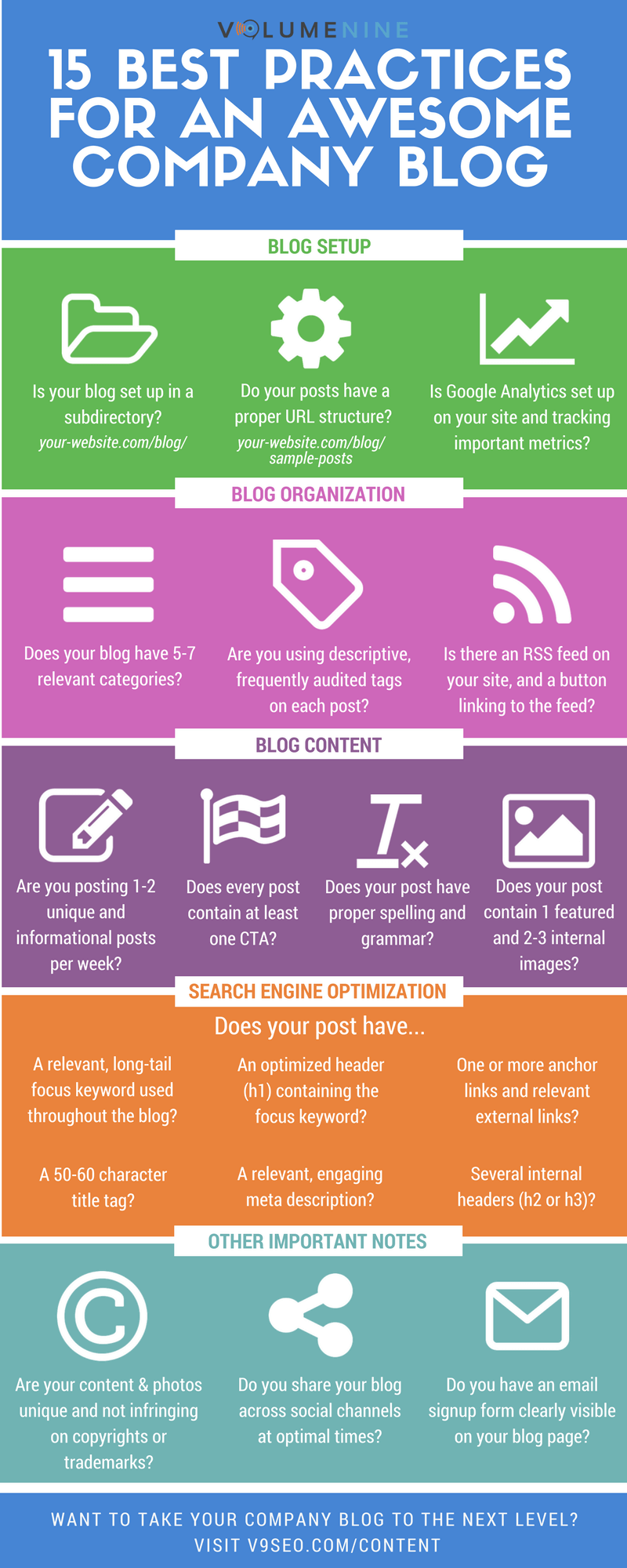Whether your company has decided to start its first blog or you’ve been blogging for a while, you’re on the right track! A company blog, when done correctly, has the power to drive organic traffic to your site, increase your search rankings, position you as a thought leader in your industry, and, ultimately, boost your sales.
However, these awesome results are dependent on whether your blog follows some key company blog best practices. If not, you may just be wasting your time with those occasional posts you write. To help you out, we’ve put together a comprehensive guide to company blog best practices. It’s long, but your bottom line will thank you in the end.
TL;DR? Scroll to the bottom for an infographic summarizing the information in this article.
Blog Setup
Subdomain vs. Subdirectory
When first setting up your company blog, you have two choices for where to build it on your main site. The first option is a subdomain, which is a way of organizing part of your existing website into a separate site. Blog subdomain URLs often look something like blog.yourwebsite. com. Search engines will treat content in your subdomain as essentially a separate site.
Your second option is to build your blog in a subdirectory. A subdirectory is a part of the site that stores a particular subset of content. Blog subdirectory URLs generally look like yourwebsite. com/blog. Search engines will view this as part of your main site.
While there is some debate in the SEO world whether you should store your blog in a subdirectory or subdomain, we recommend using a subdirectory for your blog. Research has shown that blogs set up in a subdomain see lower rates of organic traffic than those in a subdirectory.
Blog URL Structure
When setting up the URL structure of your blog posts, make sure that your subdirectory /blog/ section is included in the URL of all your posts. For example, your post URL could be yourwebsite. com/blog/sample-post.
Including /blog/ in your blog posts’ URLs serves two purposes – one, it is an easy way for your reader to know what part of the site they are on if they land on your blog post from outside the site. Two, it is an easy way to view analytics about only your blog posts in Google Analytics – simply filter any section to only show pages including “/blog/” for accurate data.
Finally, be sure to change your slug (the last part of the URL – /sample-post/, for example) to a few keywords. Often, you can make the slug your focus keyword for the article. Many content management systems, including WordPress, will automatically insert the whole title or generate random numbers into the slug. Changing your slug to an easy-to-remember phrase will help improve both user experience and SEO, and the URL will look cleaner when shared on social media platforms or promotional materials.
Google Analytics
A well-maintained, engaging, and optimized company blog has the potential to drive tons of organic traffic to your site. The best way to see how your blog is doing is through Google Analytics. When building your company blog (and your website), be sure to set up a Google Analytics account and include your personalized tracking code at the bottom of the <header> of every page. Google has a step-by-step guide for setting up tracking.
Once the tracking code is installed and tracking your site’s visitors, start monitoring certain content marketing metrics each month to see what’s working well and where you can make improvements. The most popular articles, top traffic drivers, pieces that bring in new users, posts that drive engaged visits, posts with goal conversions, blog visits by channel, and the top posts for organic, social, and paid traffic are all important metrics to track.
Top performing posts in particular can help inspire your future content. Look at what kind of content is driving traffic to your blog – do your readers love how-to articles, or are your infographics driving users to other pages on your site? Take these favorite topics or formats and create blogs in a similar style.
Blog Organization
Categories
Categories are an easy way to tell your reader what the general, overarching focus of your blog post is – essentially, this is the table of contents for your blog. We recommend that you start by setting up 5-7 categories for your blog posts – these should be broad buckets that describe many of your blog posts. Many businesses find that their categories end up being their main business focuses – for example, on the Volume Nine blog, we have categories for SEO, content marketing, social media, and digital marketing.
Every post in your company blog should be filed under one category, and one category only, and each category should have at least three posts filed under it.
Finally, be sure to display your categories clearly on your blog homepage. To function properly as a table of contents, users should be able to quickly find and navigate to the content they want to read. On the Volume Nine blog, we have our categories visible in the blog sidebar:
Properly maintained categories will help improve your user’s experience on your site, as it will make it easy for them to find relevant content about a certain topic. From an SEO standpoint, using categories optimized for target keywords will help boost your page ranking for that keyword in search engines.
Tags
Like categories, tags are another way of indicating to readers the general content of your blog posts. Think of tags like the index of your blog. Most experts believe that tags don’t provide a tangible SEO benefit, but they can improve user experience and may help increase rankings when used correctly.
If you do decide to use tags on your site, these best practices will help to make sure you’re making the most out of your tags:
- Make a list of 20-30 tags you want to use in your posts, and stick to them. Remember that minor spelling differences will create a new tag, so be sure that you consistently use the same spelling (for example, “hints” and “hint” would create different tags).
- Choose tags that can be used in at least three posts, which will improve bounce rate if a user clicks through to the tag page.
- Use 3-5 tags for each post. Each tag should give readers an idea of what content exists in their post.
- Limit the number of tags that assign to each post, and audit them frequently. If you find that after a few months, you have a tag that is used for only one post, it’s best to delete that tag and find one that is relevant to more blog posts.
- Consider using tags that are different than your focus keyword. Using your main keyword as a tag will not have any positive impacts on your SEO efforts.
- Make sure that your tags are different than your categories.
RSS Feed
Including an RSS feed on your website is an easy way to keep readers engaged, updated, and returning to your site consistently. Users can add your RSS feed to their preferred feed reader – Feedly, Feeder, and Newsblur are popular examples – and see your new blogs in their feed as soon as they are published. Those visitors that value your blog enough to add it to their feed and return regularly will help in establishing your site as a high-quality, authoritative source in the eyes of search engines.
Most content management systems automatically build an RSS feed into your site (you can view it or add it to a reader at yourwebsite. com/feed or yourwebsite. com/blog/feed), but it’s important to include an RSS button that users can click that directs them to the feed URL to add to their feed reader. Commonly, users will look for this link alongside other social buttons on your site.
Blog Content
Posting Frequency
There are varied opinions in the content marketing industry about exactly how often you should post on your blog. We recommend that our clients post high-quality, relevant, optimized blog posts at least 1-2 times per week, on the same day(s) each week.
Fresh content means that search engines will evaluate and index your site more frequently, which helps boost your rankings. Additionally, every new blog post is an opportunity to capture a new long-tail keyword that can direct new organic visitors to your site.
Note that this doesn’t mean you should whip out a 200-word, unoptimized blog post every few days. Above all, search engines value quality content, with relevant content, focus keywords, and internal and external links. Be sure that each blog is high-quality and has a clear purpose.
Blog Topic
While it may be tempting to use your blog exclusively to share exciting news about your company, brand, and products or services, you’ll find that publishing only promotional content will likely not boost your organic traffic numbers. Think about how often you search for a blog about an office remodel or a company picnic – you likely only do so rarely.
Company blog best practices suggest publishing 80% informational posts and 20% (or less) promotional posts. Informational posts that are relevant to your field and provide your readers with valuable information to help them solve a problem will be the primary drivers of organic traffic to your site.
Not to say that promotional posts lack any value. There will certainly be part of your readership that is interested in your company updates. Additionally, posts that highlight your company culture can help your business attract top talent in your area.
Plan out your content by creating a monthly content calendar that includes a due date, your post title, a description, focus keyword, and featured internal link. Content calendars ensure that you stick to a regular posting schedule and are adhering to the 80/20 guidelines.
Calls-to-Action
While you should be writing your blog with the primary purpose of providing benefit to your reader, your blog should also be beneficial to your company. Calls to action (CTAs) direct your reader to continue engaging with your brand, whether it’s through a link to another page, an email signup form, or a contact form.
Every blog post you write should include at least one CTA. Many people choose to put their CTA at the end of the article and tie it in with the topic discussed in the piece. The call to action below was at the end of an article on the Volume Nine blog about designing a great infographic:
“With these tips, you’ll find designing your own infographic to be straightforward and even fun. Want to know more about how infographics can communicate you message and promote your brand? Our team of content experts is standing by to answer your questions!”
Calls to action are also effective when placed in the sidebar of your blog homepage and individual blog pages. Use this space to encourage users to sign up for your newsletter, or contact your customer service team to discuss your products or services.
Grammar
We live in a world of spell check and grammar editing tools. There should be no reason that your post is published with typos, grammatical errors, or misused words. Proofreading your blog drafts several times before publishing will save you from any embarrassing mistakes that may detract from the power of your blog post. You may also ask your coworkers to do a quick once-over before you hit the publish button.
Outside of your coworker’s critical eye or your word editor’s built-in spell check, there are several tools available online that offer a more comprehensive grammatical review of your text. Grammarly is our personal favorite here at Volume Nine.
Blog Images
Including images in your blog is an excellent way to break up text, catch your reader’s eye, and back up points you make in the article. However, it’s best not to just cram photos in the blog and hope for the best. There are a few image best practice guidelines to follow to ensure that your pictures add tangible benefit your blog:
- Choose a featured image for every blog that fits with the context of the article. If your blog template has a set featured image size, use a tool like Canva to resize it to the proper size.
- Use 2-3 internal images throughout the post.
- Compress all images before uploading them to your content management system to minimize page loading times. Online tools like TinyPNG or plugins like WPSmush are great, free options.
- Name your image something clear, like “featured-image-for-blog.jpg”. Include your featured keyword in the title only if appropriate, and use dashes ( – ), not underscores ( _ ).
- Include an alt text for your image. The text helps visually impaired readers and allows search engines to index your image properly. The alt text should describe the photo – again, only use your focus keyword if appropriate.
- Choose relevant photos that align with or further the main point of your article. Everyone likes funny cat pictures, but they may not be appropriate to use on your company blog post.
Search Engine Optimization
We could talk for days about the best ways to optimize your blog to increase search engine rankings (after all, we are all SEO nerds here at Volume Nine). There are a few main things every blog should contain to best optimize it for SEO:
- A long-tail focus keyword that is used naturally throughout your blog and describes your content. Learn how to find powerful focus keywords for your blog.
- A title tag, which is what is shown in search engine results. Ideally, your title tag should be 50-60 characters and include the post title and your blog or company page. Example: How to Write a Good Sample Headline | Volume Nine Blog
- An optimized title/header (<h1>) containing the focus keyword. Learn more about using title tags and H1s for SEO.
- A meta description, which summarizes what the article is about to people searching on Google.
- Internal headers, or <h2> in HTML ,that break up your content and improve the reading experience for users.
- Internal and external linking. Every blog post should contain an internal anchor link directing readers to a product page or contact form. If relevant, including external links to relevant, high-quality sites boosts your page authority.
Download and print our full content optimization checklist.
Other Important Notes
Creative Infringement
Copying other’s work in school resulted in you failing the test. Using other people’s work without giving credit has more severe consequences in the real world. Make sure every blog you post is your own, or you’ve gotten recorded permission from the original author to reuse their content on your site. If you’re writing a new article using an old article as reference, include an external link to the original article as a source, and use a tool like Copyscape to test if your post is too similar to the original.
You need to be equally as cautious when using photos on your website or blog. Gone are the days where you can download a photo from Google and use it as your featured image without repercussions. All photos on your blog should either be taken by your company, or downloaded from a paid stock photo website like DepositPhotos or Shutterstock. If you’re looking for a free and legal image source, check out Wikimedia Commons. You are free to use photos available on the site, as long as you properly cite the photographer on your blog.
Social Sharing
If you’ve been applying these best practices to your blog, you should have an appealing blog full of high-quality, informational articles. Now, it’s time to amplify your content on social media to help drive more organic traffic to your site. Social sharing is an easy way for your blogs to reach an audience that may not have found the articles through search engines.
Every blog post that you publish should be shared across your company’s relevant social media channels. If you have a particularly excellent post, you can boost or promote it to particular audiences to drive even more traffic to your site. However, don’t just paste the link and click share – make sure that the link preview contains relevant, engaging information to encourage your followers to click. Facebook Open Graph and Yoast SEO are plugins that allow you to customize what title, description, and image people see in the link preview.
To facilitate the sharing of your posts by engaged users, each blog you publish should be equipped with a social share bar at the top of the page. These buttons allow for users to share your article to their preferred social media with one click. Below is an example of what a social share bar could look like:
Learn more about content sharing across social platforms.
Email Subscription
Does your company send out an email newsletter? Newsletters are one of the best ways to keep potential and current customers up-to-date on your business while keeping your company at the top of their mind. If you don’t already have a newsletter in place, it could be as simple as sending out a bi-weekly update of new blogs on your site.
Once you get your newsletter set up, or if it already is, make it easy for people to sign up for it on your site by including an email signup form on your blog page. Simplify the process by only requiring readers to enter their email address to join the list.
One Final Note
If you’ve taken the time to implement all these company blog best practices, then you may have already begun to see some improvements in your blog traffic. If not, don’t fret – content marketing is not a quick fix. Generally, it can take six months to see major results from your efforts. Until then, keep tracking your blog metrics, continue posting regularly, and enjoy watching your page views rise.
Do you have more questions about company blog best practices? Feel free to reach out to our content marketing team – we’re happy to help!





